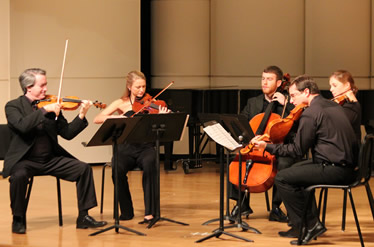Enter the bright and spacious back galleries of the Blowing Rock Art & History Museum, where Elizabeth Bradford: Time + Terrain is on view through November 19, and you are immediately struck by the terrain in the show’s title. Land, whether the shores of Greece or Florida’s Everglades or the creek beds and woods of the artist’s own state (Bradford lives in north Mecklenburg County), is the subject of the 41 paintings.
But these are not vistas seen from afar. Instead the viewer is plunged into the very midst of the landscape, often mere inches away from a tangle of wisteria vines or Rose of Sharon blossoms. There, close enough to touch tree bark and hear water rush, it is impossible to deny nature’s presence.
And that brings us to the first element of time in Time + Terrain. Bradford has spent a lifetime immersing herself in the outdoors. In one of several poetic passages that accompany the paintings, she writes about her communion with the sea on the island of Skopelos, Greece, where she enjoyed a residency a couple of years ago: “I have looked so long, unable to look away, that it has been fully absorbed.” By placing us in such proximity to the nature she depicts, Bradford asks that we, too, fully absorb it – soak up the artistry of her work, and also take that patient attention and sensitive perception out into the natural world.
Bradford’s works manifest not only her time with the land, but also her time with the paint, and it is actually that element of time that first commands a viewer’s attention upon approaching the exhibition. She has described her paintings as comprised of “a thousand tiny” abstractions, “cobbled together into a mosaic that people recognize as how the world is/could be/used to be.” Often there is a suggestion of fantasy in the startling white, shimmering silver, or ebullient colors on canvases that can be eight feet tall or just 21 x 14 inches. And while some works, like the massive “South Mountain, 2015,” appear to be perfect representations, others, like the stunning “Bone Trees, Reflections, 2015” that opens the exhibition or the enigmatic “Creekside at Dusk, 2013,” are glorious concoctions of acrylic that might easily tell a different story, were their titles less specific. These pieces, which she has described as more labor intensive, are the more compelling of the show.
The vibrancy of Bradford’s work and its subjects reminds us of yet another aspect of time: it passes, and neither we nor the land go unchanged. As Jay Everette, community affairs manager for the Wells Fargo Foundation, writes in the Foreword to the exhibition catalogue, “Bradford’s representation of nature also reminds us in some way that this beauty is temporal, and we begin to think about our role in preserving and protecting it.” And that, for Bradford, is perhaps her key message: “to love and treasure and ferociously protect the earth.”
The exhibition received funding from Wells Fargo Private Bank, and that support has contributed to extra programming to enrich a viewer’s experience, including public conversations with the artist (the next is September 15) and the catalogue, where one can read a lengthy and insightful interview with Bradford, conducted by guest curator Carla Hanzal.
Blowing Rock has long been a place to “summer,” and its rolling mountains provide equal incentive to visit in the fall. Whether escaping the heat or seeking splendid fall foliage, visitors to this quaint town in the next few months would do well to spend some time in Bradford’s terrain.











